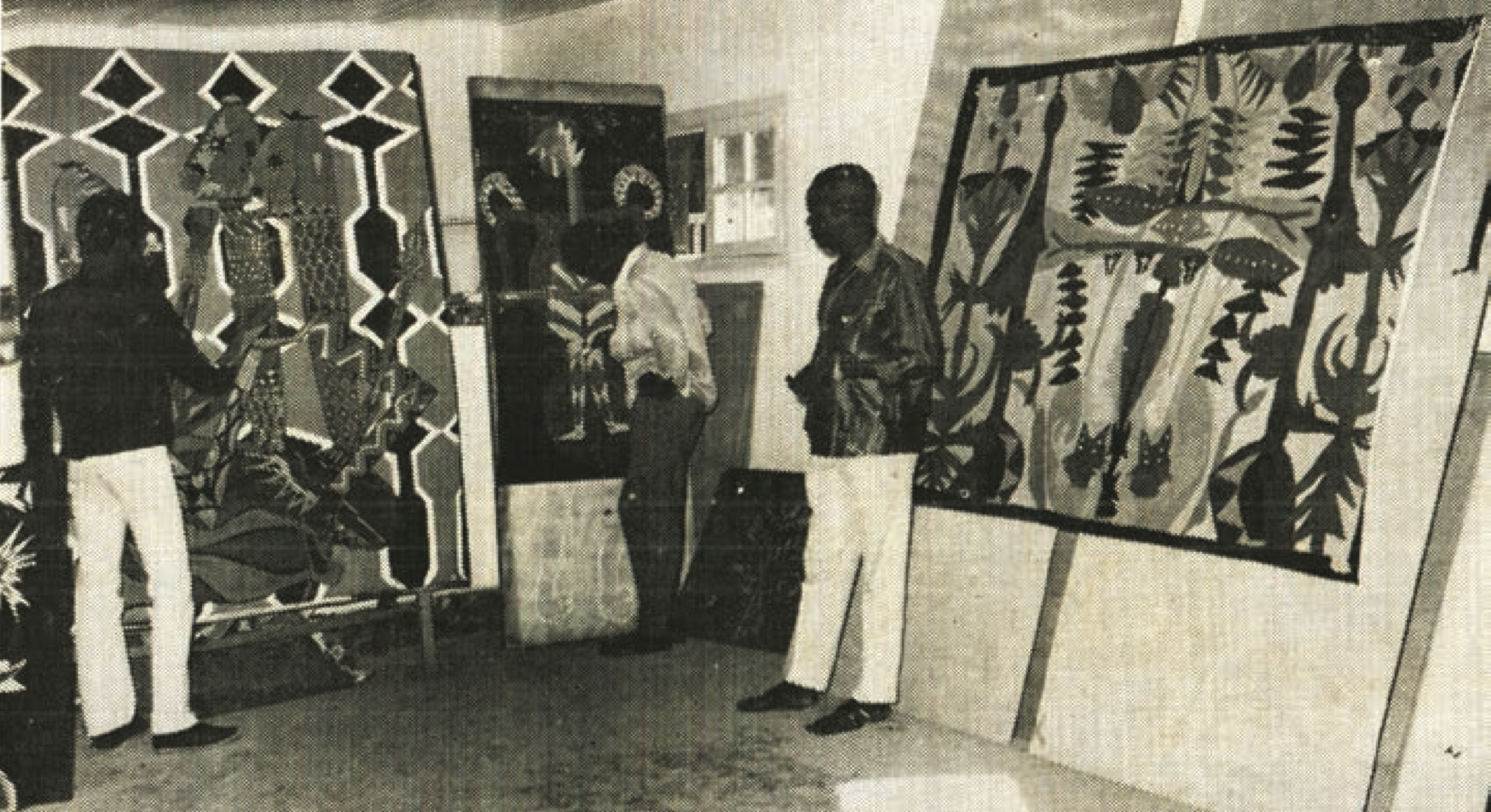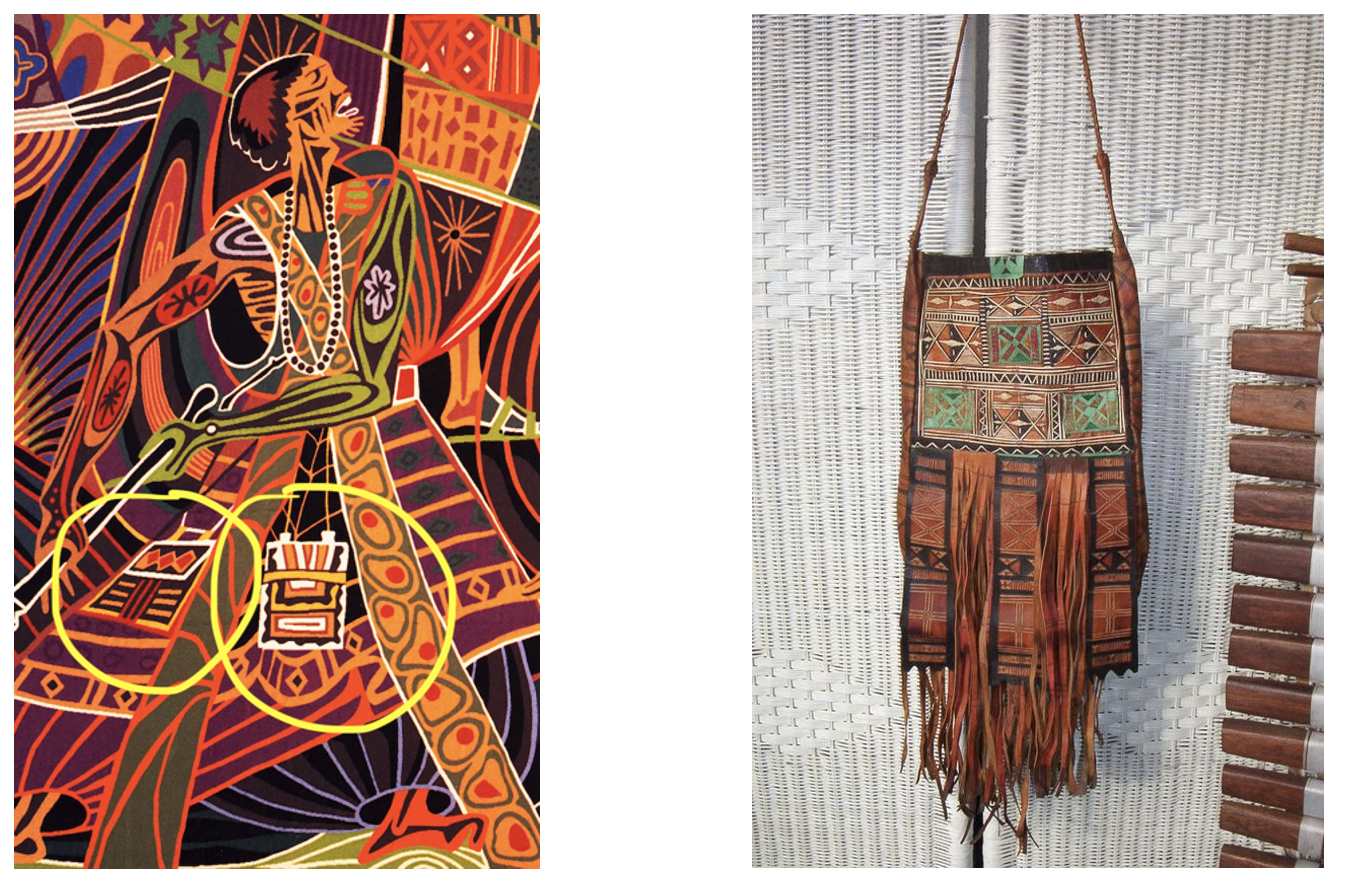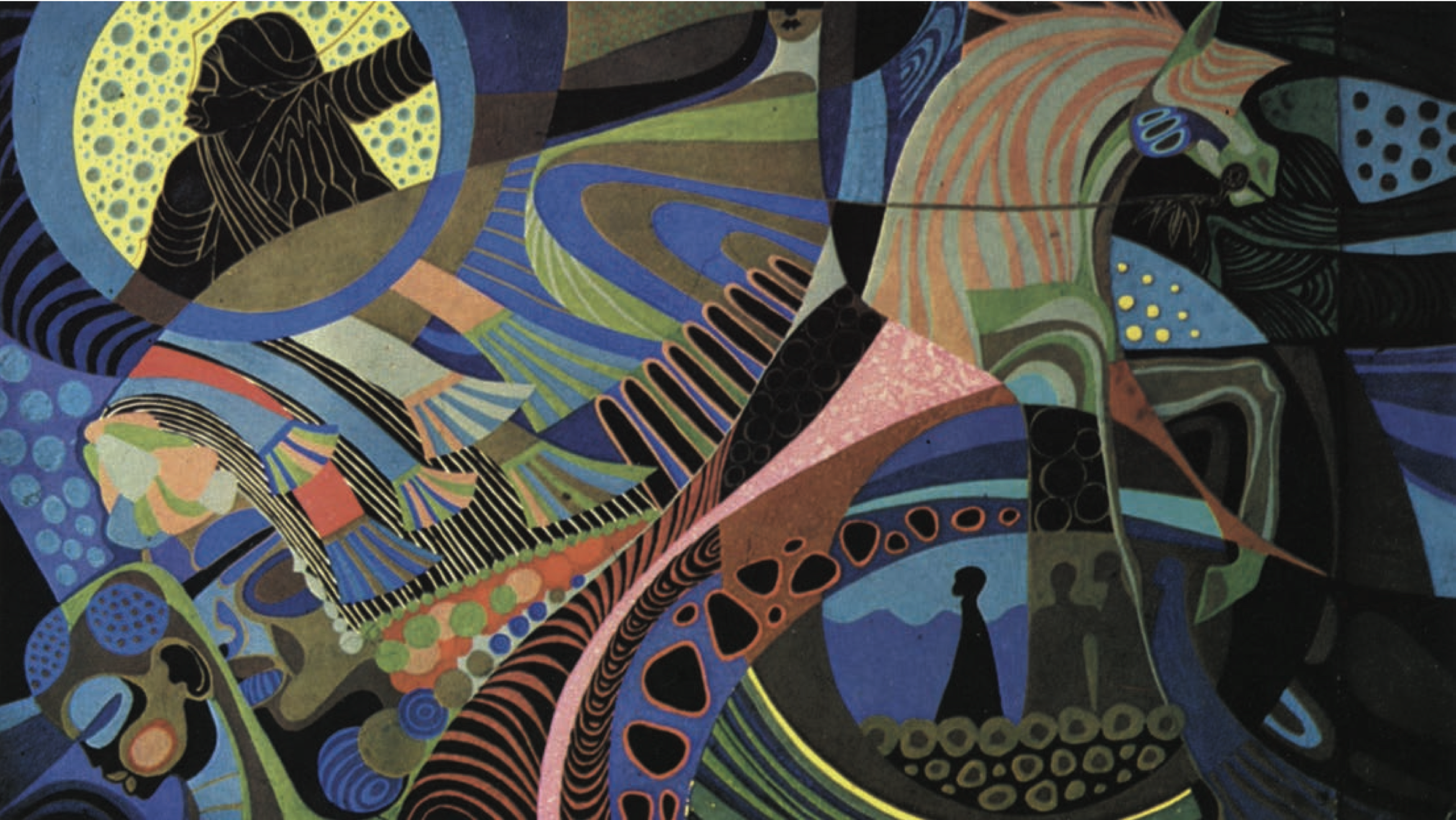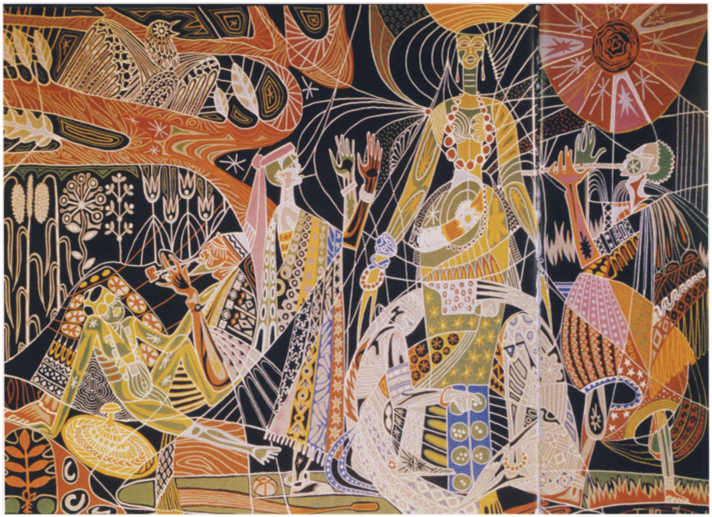
Tokens, Ancestors, and the Importance of Community:
The articulations of Négritude in Papa Ibra Tall’s tapestries, and their contributions to understanding the contemporary African identity
The nature of philosophical thought within a society endures the inherent challenge of providing an all-encompassing, authentic representation of its subjects. In Paris during the 1930s, Aimé Césaire, Léon Gontran Damas and Léopold Sédar Senghor formed the philosophy of Négritude as an inclusive African identity for both Africans and the diaspora. [1] However, like the vast space between Africa and France, Négritude harbored an implicit ambiguity — which existed even amongst its begetters. While Négritude as an African philosophy provides a perspective for African poets, writers, and artists to engage with an identity that presents itself as simultaneously traditional and modern, its generalisation of African representation has caused contestation. Modernisms equation to Westernisation has highlighted the concerning proximity between Senghor’s application of Négritude and colonialism. [2]
To Senghor, Négritude was a philosophy that centred the Black identity in the post-colonial era by providing high-grade qualities of modernism in its arts and culture. Therefore, when he became Senegal’s first-elected president, Senghor utilised Négritude to regenerate the nation’s cultural institutions and encourage artists to capture the essence of African expression. Artist Papa Ibra Tall, who was educated in Paris but returned to Senegal after independence, became a symbol for Négritude’s reverence of the Black identity. [3] He articulated Senghor’s ideas of Négritude into extraordinary tapestries by using tokens symbolic of the pre-colonial African continent, portraying the interconnectedness of African existence, and displaying the importance of community as an ontological entity. His works The Warrior, Wonders of the Bush and Pilgrimage to Touba, unpack these three characteristics, respectively, and provide prominent depictions of Négritude worth deconstructing. Their essence will provide a better understanding of Négritude’s contribution to the modern African discourse of post-colonial identities and assess the criticism and countercriticism of its utilisation in African expression.
The Warrior and Tokens of Traditional Africa
Figure 1: The Warrior (1966) [Source: Sotheby’s]
Africa, in many ways, had represented the primitive stage of human evolution due to its historical romanticisation in early ethnological studies. [4] Négritude anchored its values in symbols of Africanity. Senghor thus struggled to express an inclusive African identity while still accurately embodying the diverse communities that existed throughout the continent. This challenge could best be solved by rendering general African imagery within the visual expressions of Négritude. Therefore, one of the criticisms of Négritude is that it consists of ready-made African symbols and endures with the thought of a harmonious African history. [5]
Senghor hosted the World Festival of Black Arts (FESMAN, from the French translation) in Dakar to celebrate expressions of African culture not just on the continent but from around the globe. FESMAN was the first state-sponsored festival of African and African diasporic artists. [6] Musicians, poets, dancers, actors, filmmakers, and artists gathered in the capital of Senegal to celebrate their African heritage. The festival made Négritude very prevalent due to the attraction garnered on a global level. Amid widespread decolonization, and the civil rights movement underway in the United States, this festival aimed to recognise and celebrate the arts of Black heritage. [7] African-American superstars like Duke Ellington, as well as Césaire’s involvement in the festical, attracted a global audience. [8]
Through this festival and exhibition of culture, Senghor introduced a new national and continental aesthetic for Africa cultural expression. Tall’s painting The Warrior (1966) [Fig. 1] was exhibited at the festival’s inaugural event, thus clearly expressing Senghor’s intentions with the festival. The title itself endows the figure in the painting as a combatant and indicates a specific authority over his agency. Not only is he portrayed as very masculine, but his in-motion pose symbolises movement and a rebirth of the African man. The title implies the man could be a tribal warrior; thus, the tribular symbols that mark his upper body evoke a ‘traditional’ African. Our eyes are drawn to the flower drawing on his flexed bicep, the abstract leaves that tattoo his upper-shoulder, and the scarification on his cheeks. The detail of scarification reflects one of the widely used elements used by many West Africans to mark milestone stages in men’s and women’s lives.[9] Therefore this visually references traditional of African tribes. What draws him away from his mortality is his right arm which elongating downwards like a shadow across the canvas. The elongated hand is a common motif in Tall’s art, and it seems to place the warrior’s existence into a quasi-universal space as a godlike figure.
The quote on quote ‘primitivist’ qualities seems to exist within the abstract symbols in the paintings, but also in the ‘blank spaces’ void of texture. Unlike almost all of Tall’s works, Warrior portrays a majorily monochromatic colour scheme, which puts a visual emphasis on the patterns that decorate the figure, and the unabating curves that grow from his body. The black and white uniformity of the painting exhibits a moment of pensive thought amidst the chaos and vibrancy of the festival. It seems to say, despite the entertainment and fun of the festival, one must remember that the man signifies something far more significant; a much grounded, confident and unapologetic Africa identity.
The carefully placed hints of colour at the painting’s centre provide an environmental element to the painting. The soft blue in the circular shape in the centre of the work perhaps displays an ecological symbolism. Additionally, he walks on a concaved surface, also giving his movement a cycloidal quality. The gold lining in the left-hand corner of the painting articulates the man as possessing divine, ancestral nature.
As John S Mbiti reflects on the state of the African man, “The man’s image of himself and the universe is disrupted and must make room for the changing ‘universal’ and not simply ‘tribal’ man.” [10] The warrior in the painting represents both because Senghor believed that the existence of art in Africa was not to reflect reality but to create reciprocity with the “universe of vital forces.” [11] Modern African art had to dig beneath the surface of what was tangible and display the intangible.
One such way artists of Négritude accomplished this decree was by depicting sound, more specifically rhythm, in their works. The importance of the surroundings of the warrior reflects Senghor’s passionate conceptions of African rhythm in depicting Négritude. To Senghor, African art is a combination of “a unity of rhythmic series that respond to one another.”[12] An emphasis on the depiction of mind and body, breath and heartbeat, in this painting reflects the inherent rhythm that exists within oneself. The curved lines bring attention to Tall’s use of kinesthetic imagery to replicate the beat of a rhythm. The assemblages of curved lines stretch across the canvas’s edges and centre the man at the core of Négritude’s narrative. The lines support the body in motion, acting almost as vibrations from the man’s strides, giving his movement a sense of three-dimensionality.
Warrior was gifted to Ellington, a friend of Tall’s, but was later purchased by Sotheby’s. It was put up for auction in 2018 with an estimated sale of £8000-12000 but ended up selling for almost £199000. [13] This surprising sell can be due to various reasons, perhaps its connection to Duke Ellington, but perhaps more likely, the works reflection of the very purpose of Négritude, and its potent proclamation of the African man. Warrior renders a new agency within the African voice in global politics because it can be, and perhaps has already been, presented a political response to the self-determination of identity.
Wonders of the Bush and African Metaphysics in Négritude
Figure 2: Wonders of the Bush (1970s) [Source: Africanah.org]
Négritude’s poetic undertones situate its principles at the border between reality and ‘non-reality’. This is one reason why Négritude has been designated as obsolete in its representation of the modern African identity. The African perception of reality, to some extent, consists of “non-questions”, meaning unexplainable entities. [14] Tall’s tapestry Wonders of the Bush (1970s) [Fig. 2] depicts the human and non-human existing mutually within the universe. Wonders pays specific attention to inclusion of all the key players outlined in African metaphysics: man, animal, nature living in harmony. This interconnectedness can best be unpacked further by exploring the tapestry’s formalist qualities within the discipline of African metaphysics. As Lebisa J. Teffo and Abraham P.J. Roux explore in their paper “Metaphysical Thinking in Africa”, they prescribe, “... African metaphysics is holistic in nature”. Therefore, while African cultures are vastly different, they share similar structures of African metaphysical understandings of God and the nature of the universe.
The reaching of Négritude back to mythology and stories of ancestors has resulted in an ambiguity of Négritude that Embong designates as existing between “modern abstraction” and “traditional African... form(s)”. As Tall shows in Wonders, reality exists both in the visible and invisible forces of nature. There are evocations of storytelling, which provides a basis for the social relations in African culture. This positionality exposes an “awkward moment in which rediscovery of a past occurs through the modernist present.” In this case as was the case with many of the artists working under the umbrella of Négritude, “the authority of the traditional prevails”. [15]
The tapestry resembles a modelled portrait. A man poses with his left hand on his hip and his right hand planting a staff into the ground. A young boy sits atop his shoulders, gazing at a tropical bird that flies overhead. The elaborate details of the fabric the man wears, the feathers of the birds, and the large flowers seem to display a harmonising ecosystem. This ecosystem is perhaps Négritude’s commitment to universality, not just among humans but among the organic qualities of the Earth.
Similar to Warrior, the man in Wonders represents the African identity as a powerful, patriarchal figure. This pattern can be further developed concerning the protection of heritage regarding the child who sits atop his shoulders. According to African philosopher Sam Raditlhalo as referenced by Teffo and Roux in their paper, “a child is held to be the property of the community,” and the community “has the responsibility to support the child in becoming a valuable member of society, an asset to all.” [16] The boy, therefore, in some ways, represents a vessel for tradition. He represents the carrier of historical experience and life to keep the authentic and true African identity alive. Therefore, the tapestry displays the passing down of wisdom.
Regarding the title of the tapestry, ‘Wonders of the Bush’ validates the sense of heightened sensations displayed in this tapestry. The bright red corporeality of the man contrasted with the dark backdrop resonates with the man as the central figure of this tapestry but also gives him a fabricated perception. The electrifying colours, paired with the magical elements at play presents its subjects as more abstractly here. Nonetheless, they provide patterns and signs that can be traced back to interpretations of African culture and traditions.
As art historian Chika Okeke-Agulu wrote regarding the African artists’ relationship with modernism, “modern-inflected traditionality (or tradition-inflected modernity) claimed the African’s right to contribute to what . . . Senghor called ‘the civilisation of the universal.” [17] Therefore the further use of unusual neon colours across this tapestry is extraordinary to Tall’s oeuvre and African art, which appeals to the values of global modernity. Tall strives to find that middle-ground between modernity and tradition through the combination of ancestral depiction and modified representation. The lack of three-dimensionality, the hollow eyes of the two figures who also lack any distinct facial features, puts forth these artworks into an environment of storytelling. The anonymity of the figures poses them as metaphorical symbols and evokes the African masking tradition. Therefore, Tall’s rendering of mythology within this tapestry presents an ode to African ancestors. This application of African metaphysics to communicate the values of Négritude rejects the Western theory of rationality in philosophy, which Teffo and Roux validate as the “African perception of reality”. [18] That is not to say that there is no truth in the African perception of reality, but rather that Tall’s tapestry reflects that reality exists far beyond the mortal limits of human.
The Pilgrimage to Touba and the Ontological Importance of Community
Figure 3: Pilgrimage to Touba (1968) [Source: modernismmodernity.org.]
The importance of community has always been central to the cultivation of contemporary African epistemology. Historically, tribes have persisted in unity. As examined in Wonders, the innate connections of the living with ancestors has strengthened the social relationships between people since the beginning of time. Négritude strives to find a commonality that every African tribe share, they share the same continent. Tall’s tapestry Msaggala Tuubaa or “Pilgrimage to Touba” [Fig. 3] references the largest religious gathering in West Africa where four to five million pilgrims gather in the holy city of Touba in Senegal. In this period, the travelers commemorate the life of Seikh Amadou Bamba, a Muslim spiritual leader. [19]
Pilgrimage was a commissioned piece that Senegal gifted to the UN in 1980. [20] The gifting of this 4 metre high, 6 metre wide tapestry also reflects what Ima Ebong states, that “artworks under state ownership often function as instruments of diplomacy: art and artists were seen as ambassadors for the ideals of a modern progressive African state.” [21] Pilgrimage acts as a function of diplomacy through its depiction of such a historical event. The display of this tradition celebrates the diversity and unity that this event brings to Africans. This piece, therefore, implies Senghor’s persistence of Africa to engage with global players in their authentic approach. Interestingly, Senghor would resign his position as president only two months after this tapestry’s gifting to the UN, which places an added value to its significance of Senghor’s longevity of Négritude’s influence and seeking an alliance with the world.[22][23]
In Elvis Imafidon’s deconstruction of knowledge as shared knowledge, he points out that it is the responsibility of the community to foster the development of an individual. “Hence,” he writes, “there is an emphasis on shared standards and shared norms as crucial to the survival of both the community and the person.” [24] Firstly, the inclusion of the three entities of man, nature, and animal provides a canvas on which to depict the inherent connections between them. Secondly, the values of shared patterns of being are reflected in the complimenting colours and patterns across this tapestry.
Regarding the depiction of the figures, Tall portrays different cultural communities coming together for the pilgrimage. Even within each person’s makeup, there is an amalgamation of different identities evident through multicoloured limbs. There is also an exaggeration of clothes in general throughout the tapestry, perhaps to simulate the curves of Tall’s signature wavey patterns. The bodies blend into the curves, making it hard to distinguish with sure accuracy what or who each figure is meant to symbolize. Despite their general uniformity and similarity in colours and patterns, the figures each wear nomadic dress and carry unique accessories to distinguish from one another.
Some of the figures carry curious devices such as a bat as seen in the left-bottom-corner of the tapestry, or percussion instruments as seen in the upper-left-hand corner and the tapestry centre. A few of them carry one or multiple bags like leather ones worn by the Tuareg tribe in Niger and Mali. [25] Furthermore, one of the figures calling out to another figure wears a Kaka arm bracelet traditionally worn above the elbow, a distinctive sign of the Mossi people of Burkina Faso. [26] Finally, the hats worn by a few figures are an exaggerated version of hats worn by the Igbo people of Nigeria. [27] [28] The very different figures in the painting are agents of Négritude, spanning across nations. While more research must be done into the origins and the individual meanings of each figure, they reflect the importance of community and the ongoing motif of “I am because we are”.
This tapestry therefore strives to depict both the blending of cultures as well as civilisations of Africa. There has historically been a tremendous amount of cultural integration between different African social circles. Amidst significant movements through migration and trade just between African people themselves, this tapestry celebrates a sense of pan-Africanism not just in trade and migration, but now that of knowledge and art. Therefore, the various figures included in the tapestry signify an image of nationhood and the community and provide a sense of philosophical reflection by displaying the interactions between individuals across time and space.
As Mbiti importantly notes, “Without warning and without physical or psychological preparation, Africa has been invaded by a world revolution. Now a new and rapid rhythm is beating from the drums of … modern communications and mass media … cities and towns. Nothing can hold this rhythm or slow down its rapid tempo. The man of Africa must get up and dance, for better or for worse...”. [29]
It is understood that Négritude was born within a French colonial space therefore the goal of Négritude was never solely to articulate an authentic African thought, but rather to paint a reflection of the African perspective of nature and reality. [30] Négritude pushes the African identity across the globe, therefore it was never anchored within the continent of Africa, but rather is freely existing within those who associate with it.
While there still exists a very present criticism, it is important to find ways to reformulate Négritude into contemporary discourses. Artists must continue to find ways to articulate their identity and to communicate it visually, and emotionally. Tall evoked pre-colonial symbols and traditions and represented them in the postcolonial era. His tapestries stand the tests of time as avid, iconic expressions of a newly free identity. His memorable tapestries tower over its onlookers and hold the magnificence of the African voice.
Senghor’s reconciliation of the Black identity left many artists limited in their individual expressions. Négritude provided a defined starting point for contemporary African artistic expression. Therefore, it is worth considering whether Négritude works better as an art movement instead of a philosophy, or perhaps art movements themselves are simply visually expressed philosophies.
Yet Négritude reinvents itself every generation, it just happened to be given a name by Césaire, Damas and Senghor during a period when African expression needed to be expressively marked. Senghor’s implementation of Négritude into the modern African consciousness provided artists with a channel in which to connect with their historical identity. Tall seized this artistic channel and transcribed Négritude’s ability to encapsulate an inherent rhythm that carries humanity forward with its steady beat.














